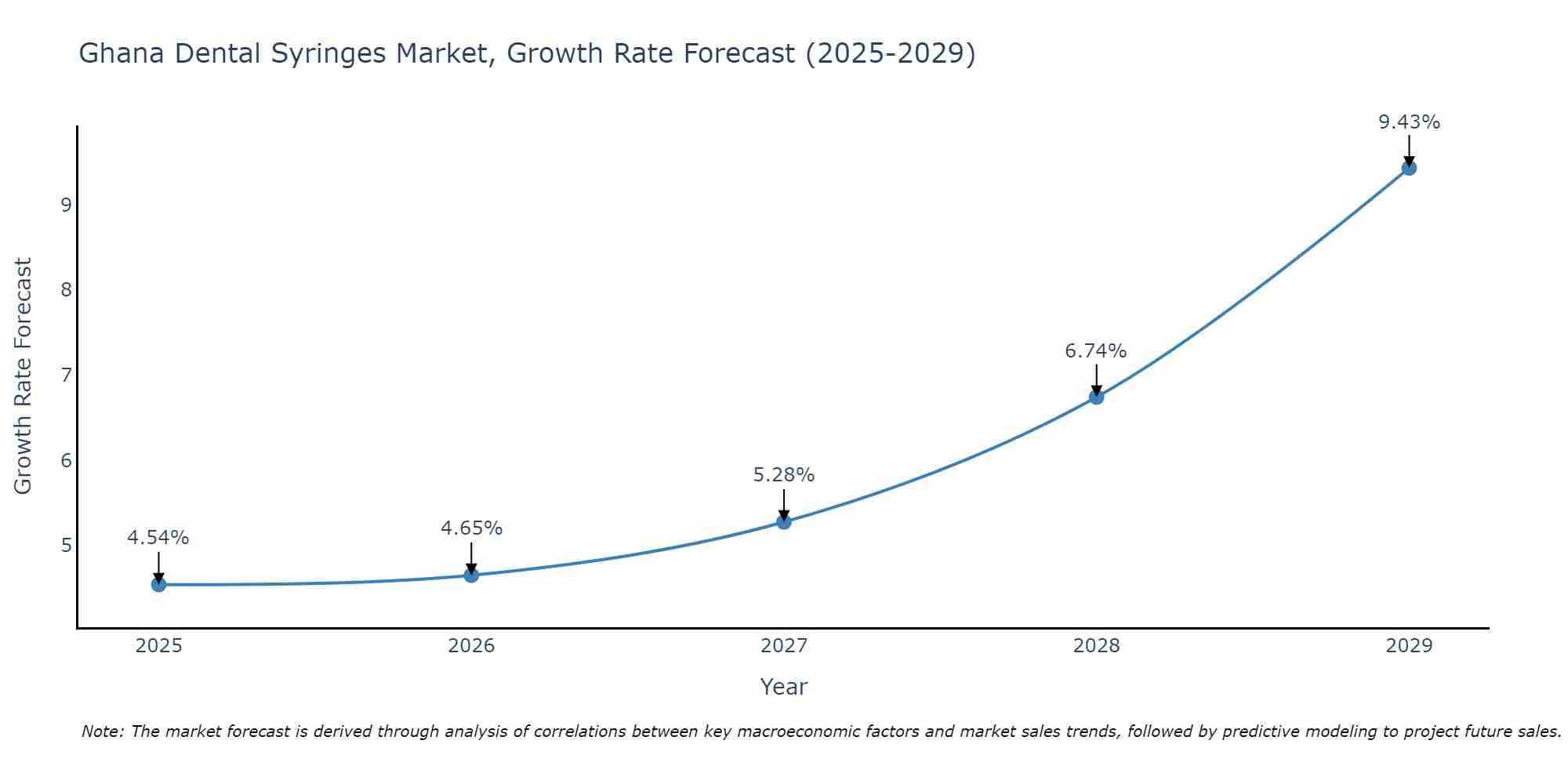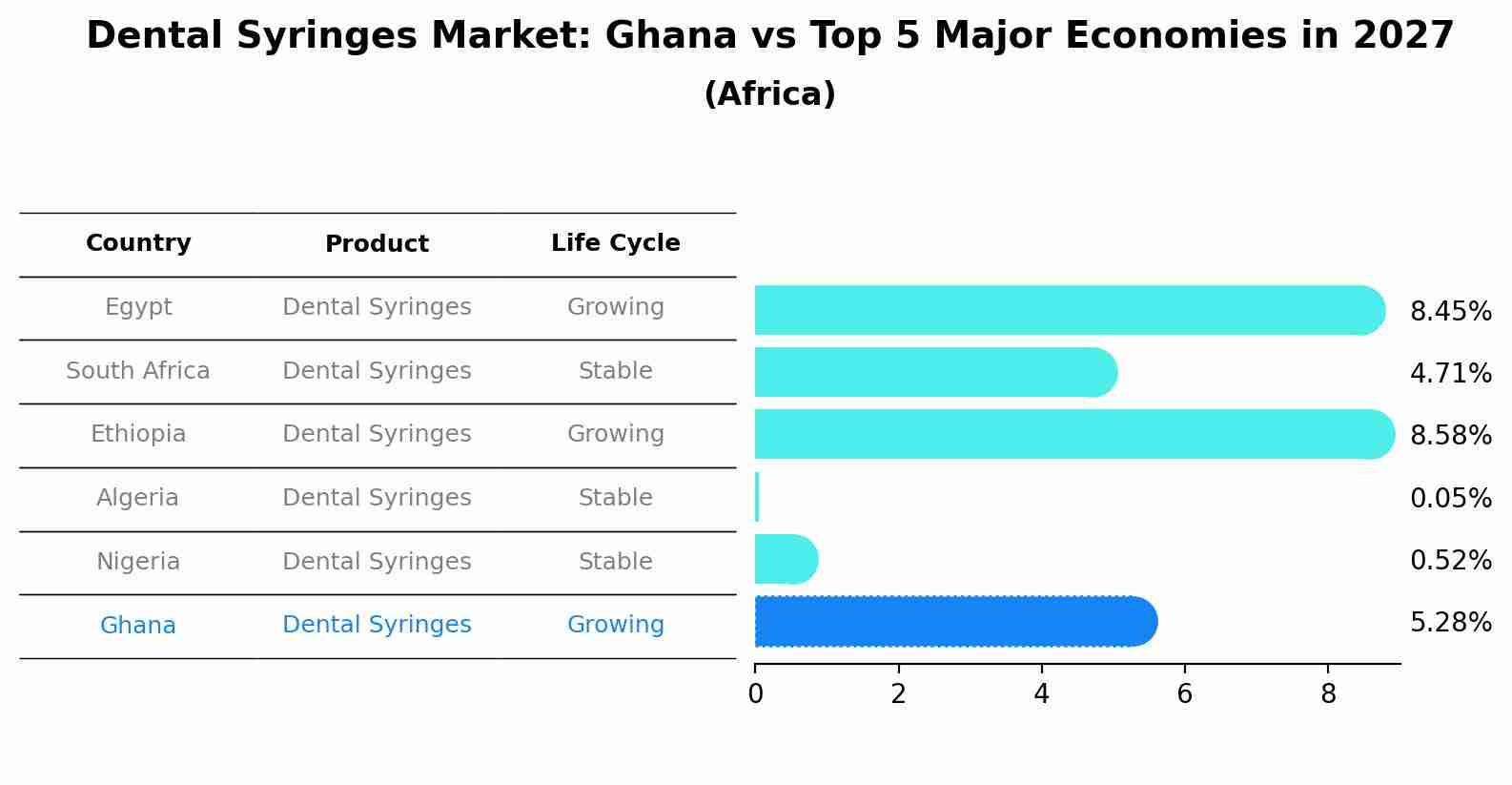Ghana Dental Syringes Market (2025-2031) Outlook | Trends, Forecast, Revenue, Industry, Share, Analysis, Growth, Size, Companies & Value
| Product Code: ETC362936 | Publication Date: Aug 2022 | Updated Date: Aug 2025 | Product Type: Market Research Report | |
| Publisher: 6Wresearch | Author: Shubham Padhi | No. of Pages: 75 | No. of Figures: 35 | No. of Tables: 20 |
Ghana Dental Syringes Market Size Growth Rate
The Ghana Dental Syringes Market is poised for steady growth rate improvements from 2025 to 2029. From 4.54% in 2025, the growth rate steadily ascends to 9.43% in 2029.

Dental Syringes Market: Ghana vs Top 5 Major Economies in 2027 (Africa)
By 2027, the Dental Syringes market in Ghana is anticipated to reach a growth rate of 5.28%, as part of an increasingly competitive Africa region, where Egypt remains at the forefront, supported by South Africa, Ethiopia, Algeria and Nigeria, driving innovations and market adoption across sectors.

Ghana Dental Syringes Market Overview
Dental syringes are used for the administration of local anesthesia and other dental medications during dental procedures. In Ghana, the dental syringes market is driven by the increasing prevalence of dental procedures and the adoption of pain management protocols to improve patient comfort and satisfaction.
Drivers of the market
The demand for precise and controlled delivery of dental materials such as local anesthetics, bonding agents, and impression materials in dental procedures in Ghana is driving the growth of the dental syringes market. Dental syringes provide accurate dosing and ergonomic design for comfortable and efficient administration of dental treatments, driving patient comfort and satisfaction.
Challenges of the market
Challenges facing the dental syringes market in Ghana include ensuring injection safety and infection control practices in dental procedures. Moreover, addressing regulatory compliance and disposal requirements for single-use syringes may pose challenges for dental practitioners and healthcare facilities.
Government Policy of the market
Government policies concerning the dental syringes market may aim to ensure patient safety, infection control, and regulatory compliance in the use and disposal of dental injection devices. This could involve regulations and standards for the design, manufacturing, and sterilization of dental syringes, as well as measures to promote proper injection techniques and waste management practices in dental practices and clinics. Additionally, the government might implement training and certification programs to educate dental professionals about the safe and effective use of syringe devices, as well as the importance of needlestick prevention and sharps injury protection. Furthermore, public awareness campaigns may be launched to inform patients about the risks of needle-related injuries and the importance of receiving injections from qualified healthcare providers in hygienic environments.
Key Highlights of the Report:
- Ghana Dental Syringes Market Outlook
- Market Size of Ghana Dental Syringes Market, 2024
- Forecast of Ghana Dental Syringes Market, 2031
- Historical Data and Forecast of Ghana Dental Syringes Revenues & Volume for the Period 2021-2031
- Ghana Dental Syringes Market Trend Evolution
- Ghana Dental Syringes Market Drivers and Challenges
- Ghana Dental Syringes Price Trends
- Ghana Dental Syringes Porter's Five Forces
- Ghana Dental Syringes Industry Life Cycle
- Historical Data and Forecast of Ghana Dental Syringes Market Revenues & Volume By Product for the Period 2021-2031
- Historical Data and Forecast of Ghana Dental Syringes Market Revenues & Volume By Reusable Dental Syringes for the Period 2021-2031
- Historical Data and Forecast of Ghana Dental Syringes Market Revenues & Volume By Disposable Dental Syringes for the Period 2021-2031
- Historical Data and Forecast of Ghana Dental Syringes Market Revenues & Volume By Other Products for the Period 2021-2031
- Historical Data and Forecast of Ghana Dental Syringes Market Revenues & Volume By Type for the Period 2021-2031
- Historical Data and Forecast of Ghana Dental Syringes Market Revenues & Volume By Aspirating Dental Syringes for the Period 2021-2031
- Historical Data and Forecast of Ghana Dental Syringes Market Revenues & Volume By Non-aspirating Dental Syringes for the Period 2021-2031
- Historical Data and Forecast of Ghana Dental Syringes Market Revenues & Volume By Material for the Period 2021-2031
- Historical Data and Forecast of Ghana Dental Syringes Market Revenues & Volume By Metallic Dental Syringes for the Period 2021-2031
- Historical Data and Forecast of Ghana Dental Syringes Market Revenues & Volume By Plastic Dental Syringes for the Period 2021-2031
- Ghana Dental Syringes Import Export Trade Statistics
- Market Opportunity Assessment By Product
- Market Opportunity Assessment By Type
- Market Opportunity Assessment By Material
- Ghana Dental Syringes Top Companies Market Share
- Ghana Dental Syringes Competitive Benchmarking By Technical and Operational Parameters
- Ghana Dental Syringes Company Profiles
- Ghana Dental Syringes Key Strategic Recommendations
Frequently Asked Questions About the Market Study (FAQs):
- Single User License$ 1,995
- Department License$ 2,400
- Site License$ 3,120
- Global License$ 3,795
Search
Thought Leadership and Analyst Meet
Our Clients
Related Reports
- Afghanistan Apparel Market (2026-2032) | Growth, Outlook, Industry, Segmentation, Forecast, Size, Companies, Trends, Value, Share, Analysis & Revenue
- Canada Oil and Gas Market (2026-2032) | Share, Segmentation, Value, Industry, Trends, Forecast, Analysis, Size & Revenue, Growth, Competitive Landscape, Outlook, Companies
- Germany Breakfast Food Market (2026-2032) | Industry, Share, Growth, Size, Companies, Value, Analysis, Revenue, Trends, Forecast & Outlook
- Australia Briquette Market (2025-2031) | Growth, Size, Revenue, Forecast, Analysis, Trends, Value, Share, Industry & Companies
- Vietnam System Integrator Market (2025-2031) | Size, Companies, Analysis, Industry, Value, Forecast, Growth, Trends, Revenue & Share
- ASEAN and Thailand Brain Health Supplements Market (2025-2031) | Strategy, Consumer Insights, Analysis, Investment Trends, Opportunities, Growth, Size, Share, Industry, Revenue, Segments, Value, Segmentation, Supply, Forecast, Restraints, Outlook, Competition, Drivers, Trends, Demand, Pricing Analysis, Competitive, Strategic Insights, Companies, Challenges
- ASEAN Bearings Market (2025-2031) | Strategy, Consumer Insights, Analysis, Investment Trends, Opportunities, Growth, Size, Share, Industry, Revenue, Segments, Value, Segmentation, Supply, Forecast, Restraints, Outlook, Competition, Drivers, Trends, Demand, Pricing Analysis, Competitive, Strategic Insights, Companies, Challenges
- Europe Flooring Market (2025-2031) | Outlook, Share, Industry, Trends, Forecast, Companies, Revenue, Size, Analysis, Growth & Value
- Saudi Arabia Manlift Market (2025-2031) | Outlook, Size, Growth, Trends, Companies, Industry, Revenue, Value, Share, Forecast & Analysis
- Uganda Excavator, Crane, and Wheel Loaders Market (2025-2031) | Strategy, Consumer Insights, Analysis, Investment Trends, Opportunities, Growth, Size, Share, Industry, Revenue, Segments, Value, Segmentation, Supply, Forecast, Restraints, Outlook, Competition, Drivers, Trends, Demand, Pricing Analysis, Competitive, Strategic Insights, Companies, Challenges
Industry Events and Analyst Meet
Whitepaper
- Middle East & Africa Commercial Security Market Click here to view more.
- Middle East & Africa Fire Safety Systems & Equipment Market Click here to view more.
- GCC Drone Market Click here to view more.
- Middle East Lighting Fixture Market Click here to view more.
- GCC Physical & Perimeter Security Market Click here to view more.
6WResearch In News
- Doha a strategic location for EV manufacturing hub: IPA Qatar
- Demand for luxury TVs surging in the GCC, says Samsung
- Empowering Growth: The Thriving Journey of Bangladesh’s Cable Industry
- Demand for luxury TVs surging in the GCC, says Samsung
- Video call with a traditional healer? Once unthinkable, it’s now common in South Africa
- Intelligent Buildings To Smooth GCC’s Path To Net Zero


















